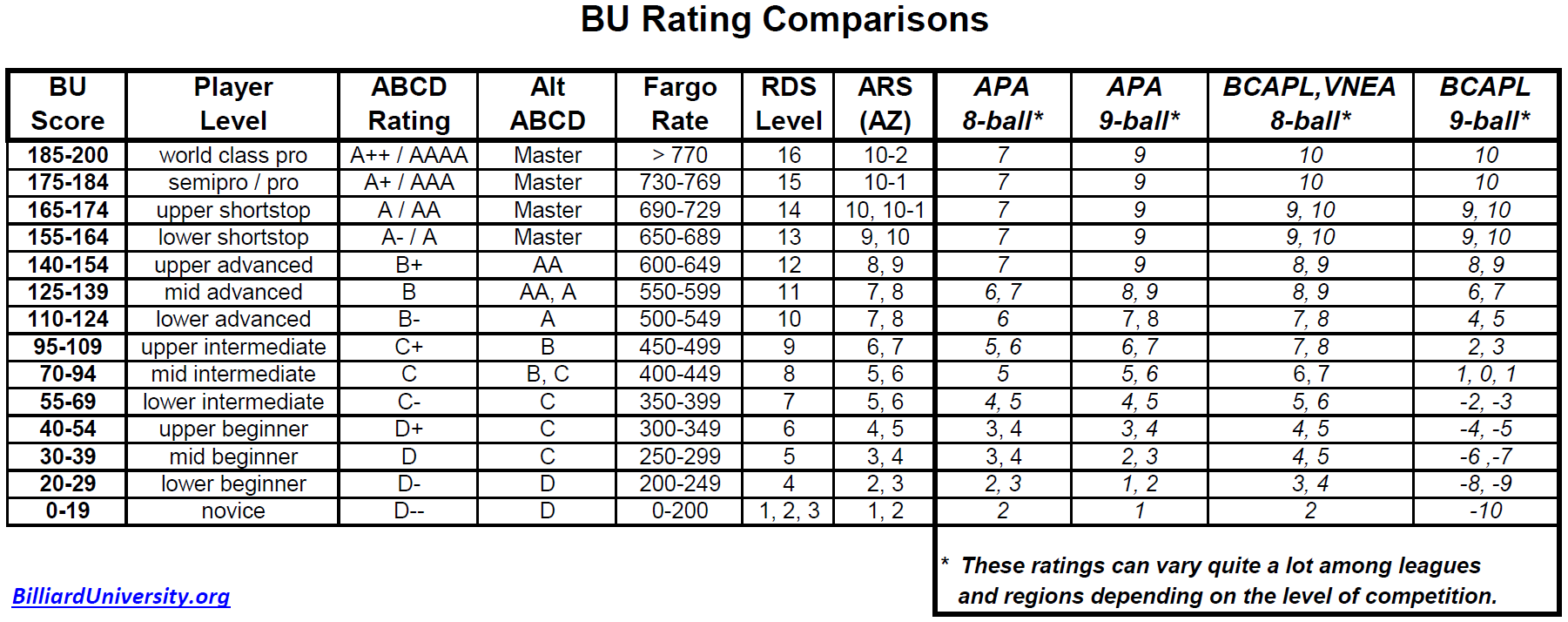How does the 15-ball-rotation player rating drill work?
from BeiberLvr (in AZB post):
1. Rack all 15 balls. Any order, but the 1 must be at the top, and the 15 in the middle.
2. Break
3. Player can take as many ball in hands each rack until all balls have been made.
4. Player does NOT have to take ball in hand immediately after the break.
5. Player can use a ball in hand at any point during the rack.
6. Play a total of 10 racks.
7. Player’s score is determined by the total # of ball in hands taken after all 10 racks are completed.
8. Slop counts.
9. Player must continue shooting even if the 15 ball drops early.
Summary of what is a foul/BIH penalty:
– CB scratch (1 foul)
– OB off table (1 foul, and ball gets spotted)
– Missed shot (1 foul)
– Missed shot and then scratch (1 foul)
– Lowest ball not hit first (2 fouls)
– Lowest ball not hit first and then scratch (2 fouls)
– Make a ball and scratch (1 foul). If a legal hit is made, but the ball that dropped wasn’t the lowest ball, it gets spotted. If the lowest ball was made, it stays down.
from dr_dave (in AZB post):
I suggest the following for score-based player ratings:
0-20 Pro
21-35 A
36-50 B
51-65 C
66-80 D
81+ BANGERAlso, here are some additional rule clarifications:
– Each ball in hand (BIH) taken counts as a penalty point.
– All of the foul points listed above are penalty points.
– Balls made on the break stay down, even on a scratch (although, a scratch on the break results in a penalty point and BIH).
– You get BIH after a scratch, and this counts as only 1 penalty point.
– “Slop counts” means balls don’t need to be called and every pocketed ball stays down, unless there is a foul as described above.
– The score is the total number of penalty points resulting from BIHs and fouls.
Here are some example racks with good scores: Dr. Dave practicing 15-ball rotation. Scores and videos for a wide range of AZB users can be found on the AZB BU thread.
A better system for determining and monitoring a player’s level of ability is the FargoRate rating and handicapping system. If you don’t have a FargoRating, you can approximate your rating with playing-ability tests like the Runout Drill System (RDS) or the Billiard University (BU) Playing Ability Exams. They assess a wide range of important pool skills in a methodical, thorough, and consistent way. They also provide a numeric and descriptive rating. The BU rating comparison chart shows how the BU rating correlates to other commonly used rating and handicapping systems, including the ABCD rating system:

For more information, see “Player Ratings” (BD, December, 2020).
Note – An interesting game based on 15-ball is called American Rotation. A brief description, detailed rules, score sheets, and more information can be found on the American Rotation resource page. A Filipino version (called Rotation) has more-complex scoring.
Dr. Dave keeps this site commercial free, with no ads. If you appreciate the free resources, please consider making a one-time or monthly donation to show your support:
